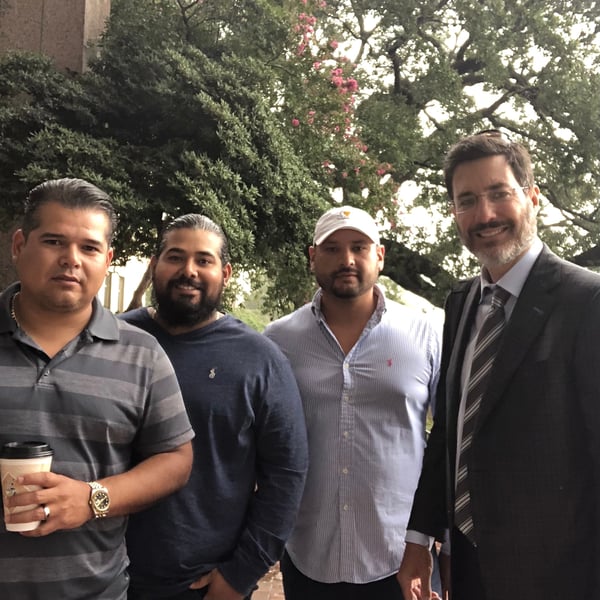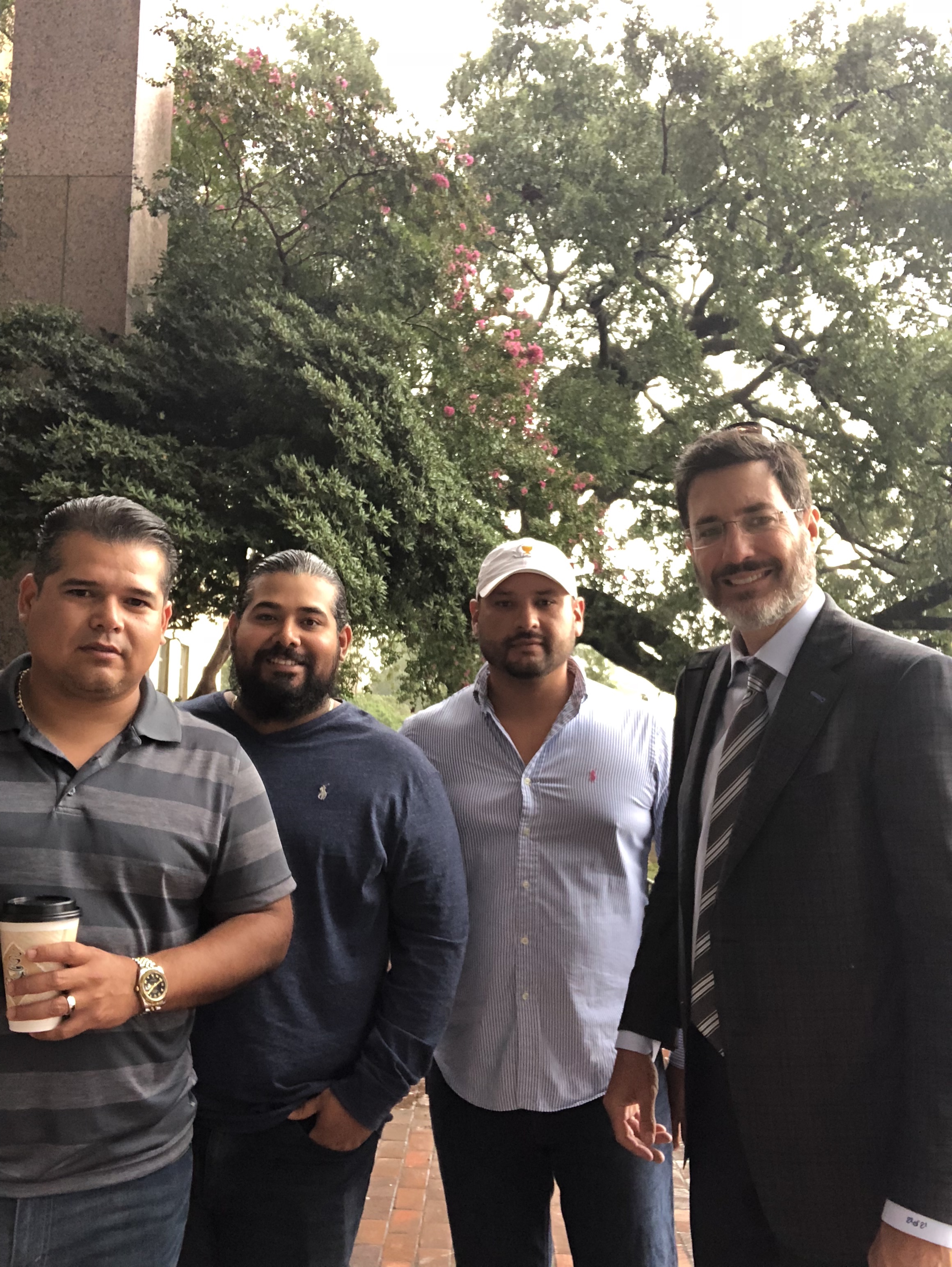

We got a $44,370,000 verdict for the family of a rigger who died in a crane accident. Before the trial started, the family was offered $500,000 for the loss of their loved one. He was a brother, a son, and a father to three young girls. The jury agreed with the family that the crane company should be held accountable for their decisions. This verdict was handed down on September 13, 2018. Click here to read the jury verdict form.
At this trial, B&G Crane was the only defendant.
The turnaround job at ExxonMobil’s Beaumont, Texas refinery
In early 2016, ExxonMobil was preparing for a turnaround job of Crude Unit A at its refinery in Beaumont, Texas. During this time ExxonMobil was shutting down part of its refinery for maintenance work.
ExxonMobil hired various contractors to do work at its refinery during the turnaround. The turnaround areas of the refinery was not producing and therefore not making money. Therefore ExxonMobil schedules the contractors to work 24/7.
For this turnaround, ExxonMobil hired B&G Crane Services, Inc. to perform crane work, and AltairStrickland, Inc. to perform rigging work.
B&G Crane provided written safety promises
 Before getting hired for the turnaround job, B&G Crane submitted its Safety Plan to ExxonMobil. In its Safety Plan, B&G Crane promised to:
Before getting hired for the turnaround job, B&G Crane submitted its Safety Plan to ExxonMobil. In its Safety Plan, B&G Crane promised to:
- Provide cranes and crane operators to lift heavy equipment out of elevated areas in the refinery;
- Address, and eliminate or mitigate, all known hazards of its lifts, including the 5 hazards presented by the lift in question: obstructions, overhead, blind, critical and weather;
- Determine if any of the lifts were “critical lifts,” which would require additional safety precautions; and
- Provide an “Account Manager” and two “Site Supervisors” at the turnaround job.
B&G Crane violated the safety rules
After being hired, B&G Crane chose not to do any of the safety planning it had promised:
- It chose to do nothing to address, eliminate or mitigate any of the known hazards of the lifts it was going to be performing on the turnaround job;
- It chose not to do anything to determine if any of its lifts were “critical lifts”; and
- It chose not to have any of its managers or supervisors on site when the lift in question occurred.
This lack of safety planning by B&G Crane was compounded by the fact that B&G Crane chose not to train its crane operator how to safely plan and execute lifts. In fact, B&G Crane knew this particular crane operator had done prior jobs without even reading the B&G Crane safety plan. B&G Crane never disciplined its crane operator for not reading its safety plans, and its crane operator never read the company’s safety plan for this turnaround job or for this lift in question.
The aftermath of B&G Crane’s safety violations
At midnight, on May 10, 2016, B&G Crane started the job of lifting a 12 ton heat exchanger from an area of the refinery 5 floors above ground level. Because B&G Crane chose not to do any of the safety planning it promised to do, and because it chose not to train its crane operator, the heat exchanger made contact with a 1,000+ pound water pipe during the lift, causing it to fall on one of the riggers, crushing him to death.
During the lift, B&G’s crane operator faced several red flags:
- Heard the riggers say a pipe was in the way;
- Heard the riggers call for equipment commonly used for “bull-rigging”;
- Saw on the crane instrumentation that his load was getting lighter; and
- Lost communication with the rigger with whom he was communicating.
The B&G crane operator did not stop the job after any of these red flags. Instead, he chose to do nothing. A few minutes after the fourth red flag, the pipe fell and killed the rigger.
Even after this fatality, this crane operator did jobs with B&G Crane where he would not read the company’s safety plan, and the company did nothing about it.
B&G Crane’s arguments point to ExxonMobil and AltairStrickland in court
B&G Crane denied any responsibility for the fatality. They argued that ExxonMobil was 50% at fault and the company that employed the riggers, AltairStrickland, was 50% responsible.
As to ExxonMobil, B&G Crane argued that ExxonMobil had previously planned to remove the pipe that fell, but directed the lift job to continue without doing so. B&G Crane further argued that ExxonMobil knew its pipe that fell was “super brittle,” “out-of-spec,” and “over 60 years old,” but failed to warn anyone. In addition, B&G Crane argued ExxonMobil failed to enforce ExxonMobil’s crane procedures which applied to the lift in question. These points were never in dispute.
As to AltairStrickland, B&G Crane argued the riggers allowed the load to make contact with obstacles, and failed to inform the B&G crane operator that this was occurring. In addition, B&G Crane argued that AltairStrickland provided a rigging crew that did not have the NCCER (The National Center for Construction Education and Research) certifications required by ExxonMobil. These points were never in dispute.
The jury verdict
 We tried this case over a period of 2-weeks. The jury deliberated over the course of 3 days.
We tried this case over a period of 2-weeks. The jury deliberated over the course of 3 days.
The jury concluded B&G Crane was 45% negligent in causing the rigger’s death, ExxonMobil was 45% negligent, and AltairStrickland was 10% negligent.
The deceased rigger did not have a spouse, but left behind three daughters and his parents. Both the riggers’ brothers who witnessed his death brought a bystander claim, and one other rigger brought an injury claim.
Our lawyers Vuk Vujasinovic and Byron Alfred asked the jury to award at least $32 million in order to compensate the family and victims, and to make our communities safer by deterring companies from putting speed and profits over safety.
The Jefferson County jury verdict awarded compensatory damages of $44,370,000.
The defense team
B&G Crane’s insurance carrier for this case was Zurich. The highest pre-trial offer was $500,000.
Over the course of this B&G Crane accident case, B&G Crane was represented by the national law firm of Wilson, Elser, Moskowitz, Edelman & Dicker. The Wilson Elser firm has over 800 lawyers in over 35 offices across the United States. The Wilson Elser trial team in this case consisted of Kent Adams, Russell Heald, and Michael Jacobellis.
B&G Crane continues to claim “the industry’s best safety record” on its website.
Related press:
- Texas Lawyer: “Litigator of the Week: Houston attorney wins $44 million verdict in refinery accident trial“
- SE Record: “JC jury delivers $44M verdict for fatal workplace accident at ExxonMobil refinery”
- SE Record: “Multi-million dollar judgment stands in fatal workplace injury suit against B&G Crane”
Topics: Featured

